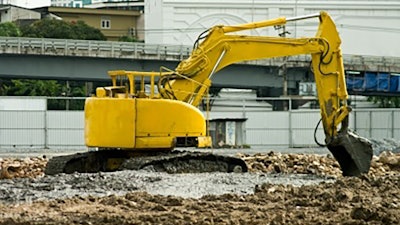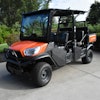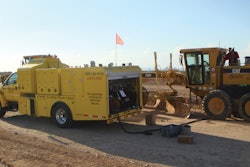
If you’re in fleet management or the construction industry, you undoubtedly have machines that run on diesel fuel. In addition to large trucks, more than 75% of all heavy construction equipment uses diesel. It offers fuel efficiency, reliability, power, performance and lower carbon emissions than gasoline.
When it comes to keeping these machines up and running, you can save time and money by learning how to properly maintain your diesel fuel injection systems. Knowing the problems to watch for and how to address them could help you avoid machine downtime and expensive equipment failures.
How do diesel fuel injectors work?
Diesel fuel injectors pressurize diesel fuel and pump it through a fixed or electronically controlled aperture (opening). This delivers fuel to the engine as a fine mist or spray — making it easier to ignite than a heavy, solid stream. The mist also burns more efficiently and evenly.
When fuel injection systems are not properly maintained, the process is less-than-effective, and can even lead to a full engine breakdown. The most common issues that negatively affect diesel fuel injection systems include clogged/dirty fuel injectors and water or air in the fuel injection system.
Before checking for or addressing these issues, safety precautions should be taken to avoid injury.
Read next: Is the Fuel Injection a Diesel Engine's Most Sensitive System?
Depressurize diesel fuel injection system before maintenance
Caution when working on a diesel system is of the utmost importance. Because diesel fuel is under high amounts of pressure when operating, it is crucial to let your engine cool completely and depressurize the fuel injection system before performing any type of maintenance. This will protect you from dangerous sprays of fuel when removing the fuel filter.
To depressurize your fuel injection system:
- Shut off engine. Before starting work, always shut off your engine and allow it to cool completely.
- Loosen fuel filter cap. Slightly loosen the fuel filter cap without fully removing it — you will hear a hiss when cap is loosened.
- Locate and loosen fittings on fuel lines. Consult your owner’s manual to determine where your fuel lines are. In some vehicles, they are mounted on the undercarriage’s frame rail — while on others, they are in the engine compartment. Once you locate your fuel lines and fittings, turn a flare wrench counterclockwise to loosen (but not remove) the fittings.
- Wait for pressure to release. Wait several minutes for pressure to release. Clean up any spills while waiting.
- Remove fuel lines if replacing filters. If you are replacing your fuel filters, remove the fuel lines completely. If you are doing other work, simply leave them loosened until maintenance is completed.
Signs of clogged or dirty fuel injectors
Because diesel fuel is more viscous than gas, it will hold dirt and debris in suspension more easily. This is why every possible measure should be taken to keep your injector systems and the fuel itself clean. If an engine’s fuel injectors are clogged or dirty, the diesel fuel may simply dribble out instead of spraying a strong, fine mist. This can cause engines to skip or stop entirely.
Signs that you may have a clogged or dirty fuel injector include:
- Rough idling
- Hard starting
- Throttle hesitation
- Decreased fuel mileage
- Poor engine/machine performance
- Black smoke from the exhaust manifold
- Pinging sounds (officially referred to as pre-ignition)
It is also important to note that cracked or broken fuel injectors or injection system parts can cause the same problems as clogged or dirty ones. Regular servicing and maintenance are paramount to keeping your diesel engine running safely and effectively.
Tips for keeping fuel injection systems clean include:
- Change oil regularly
- Replace filters
- Consider using high-quality additives aimed at protecting parts and keeping them clean (consult the manual or manufacturer for recommended additives for your machine).
Vehicle and machine models differ. You should consult your owner’s manual or manufacturer before performing work, but a few basic steps for changing diesel fuel filters include:
- Depressurize system as outlined above.
- Use your owner’s manual to locate the fuel filter (generally on the rear side of the engine)
- Find the sensors attached to the bottom of the fuel filter and remove the sensors’ wire plugs.
- Drain excess diesel by placing a pan under the fuel filter and opening the drain valve.
- Open the lid of the fuel filter can and use a fuel filter tool to unscrew the fuel filter — making sure to check for o-ring and bring can straight up without tilting (more fuel will drain into the pan as you perform this step).
- Lubricate new filter with diesel fuel and then place into fuel filter can — grease o-ring before placing it onto new filter.
- Put filter can back into position and close the drain valves — using fuel filter tool to tighten screws.
- Place wire plugs back onto sensors and follow bleeding procedures as outlined in your owner’s manual.
- When work is complete, turn engine on and check for any leakage.
Signs of water in fuel injection system
Water in a fuel system can cause the engine to miss or stop completely. Many of today’s fuel filters will automatically clog when exposed to water and immediately stop fuel flow. Any water that enters the tank upon fueling or forms via condensation will likely settle to the bottom of the tank and should be drained off each day in accordance with your machine’s manual.
Signs that you may have water in your fuel injection system may include:
- Pressure indicators showing varying degrees of pressure
- Engine missing or stopping entirely
- Fuel that appears dark and gummy — this is due to water mixing in with diesel fuel and causing microbe formation
- Sluggish performance
- Erratic idling
Tips for keeping water out of the diesel fuel injection system include:
- Drain it daily (if it’s an above-ground tank)
- Check for water — extract a small amount of diesel fuel using a hand-operated bilge pump into a transparent glass container. Check for discoloration. Water is heavier than diesel fuel and will settle to the bottom if it is present. You can also look for a thin, dark line between the water and fuel. This indicates that micro-organisms have developed, and a biocide should be added.
- Allow fuel to settle — before performing any maintenance, allow your fuel to settle in the tank — preferably for at least a full day.
- Bleed or pump water from tank
- Fill the tank at the end of each shift if possible
Read next: Water in Diesel Fuel Can Wreak Havoc in Engines
High pressure direct injection systems will return hot fuel to the tank. While most systems have fuel coolers to reduce the heat, the tanks are still above ambient temperatures and will hold more moisture than ambient air, creating a hot and humid environment in the fuel tank.
When the tanks are left to cool overnight, the moisture condenses out, putting water into the fuel. By refilling your tank at the end of each shift, that will push out as much humid air as possible and limit the potential of water in the system.
If your fuel is in a storage container designed for diesel, the container should have fuel-water separators with petcocks at the bottom. Many are see-through so you can see when water has been fully drained.
To remove water from the actual fuel tank, you can pump the water out from the bottom using an extension hose attached to the bilge pump.
In accordance with your owner’s manual, add a biocide to your fuel in order to get rid of any micro-organisms.
Signs of air in fuel injection system
If you’ve ever accidentally allowed your diesel machine to run out of fuel — you know it can cause hard starting. This is because too much air in your system will keep fuel from flowing adequately and will disallow fuel pumps to pick up and push diesel through the piping system. You should check your maintenance manual to learn how to properly “bleed” air from your fuel system.
The most common way to avoid this issue is to not let your machine run out of fuel in the first place. Steps for bleeding air from your fuel injection system include:
- Follow all instructions above and in your owner’s manual for allowing engine to cool and depressurize.
- Put enough diesel fuel in your tank to fill higher than the fuel filter.
- Loosen bolt on top of fuel filter can to enable fuel to push air up and out.
- Once all air is pushed out, tighten the bolt back up.
- Bleed air from high-pressure fuel pump by cranking engine without starting to build pressure and use wrench on injector nut to turn and allow air to hiss out and close. This should be performed on all injectors.
Diesel fuel injection maintenance tips
Diesel fuel injection systems should be cleaned and maintained at least every 36 months or 45,000 miles — or more often for heavy-use machines (such as long-haul trucks). Consult your engine manufacturer regarding proper timing and frequency of maintenance for your machine, vehicle or fleet.
In addition to the tips listed above, a few basic guidelines for regular fuel injection system maintenance include:
- Follow safety procedures before work.
- Change oil at recommended intervals.
- Change fuel filters every 10,000 to 25,000 miles.
- Use a wet sponge or something similar to wipe down engine bay.
- Use an old toothbrush to clean the nooks and crannies of diesel fuel injector systems.
- Use specialty degreasers to safely dissolve any gunk on engine or system components (consult your owner’s manual before using any products).
There are several fuel injection cleaning products on the market that are designed to be ran through your system, but you should speak to your manufacturer before putting anything into your engine.
Diesel-powered machines are expensive and crucial to one’s business — so it is important to ensure your engine receives cautious, expert-level servicing. Your best bet is to take it to a trusted, expert technician for regular servicing.
Diesel fuel quality
Finally, the quality of diesel fuel that you use in your machine is paramount to its performance. Low-quality diesel fuels can result in higher emissions, wear on fuel systems and sluggish engine performance. High quality diesel is lower in sulfur and offers optimal lubricity. Consult your manufacturer to determine the most highly recommended diesel fuel for your equipment.
Many new engine technologies call for lower viscosity oils. These advanced, low-viscosity oils result in greater fuel efficiency, especially in newer vehicles. For instance, Phillips 66 and Exxon Mobile recently introduced full-synthetic CK-4 and FA-4 oils to their lineups.
CK-4 can be used for current and older engines and is backwards compatible with many older oil types. It offers superior wear and oxidation protection when compared to CJ-4, is rated for highway and off-road use and is available in viscosity grades of SAE 15W-40, 10W-40 and 10W-30. Even lighter viscosity grades are being rolled out.
FA-4 is made to accommodate higher temperatures and oil pressures in engines released after 2016. While it is not backwards compatible because of lower HTHS viscosity, it must pass the same tests as CK-4 fluids.




















